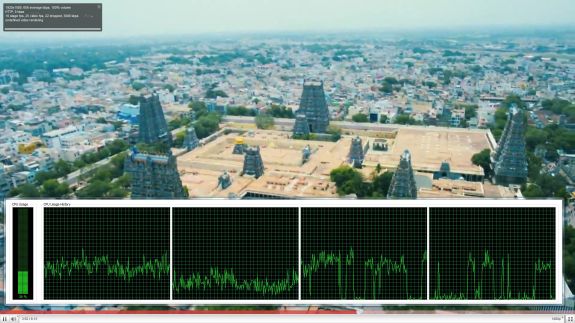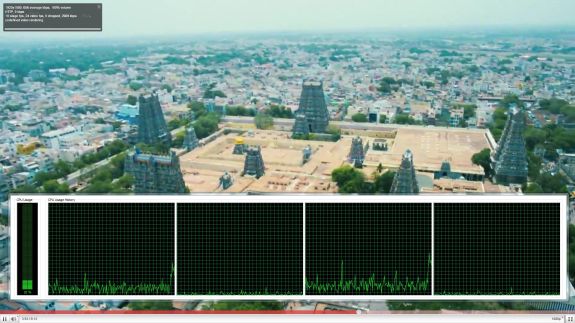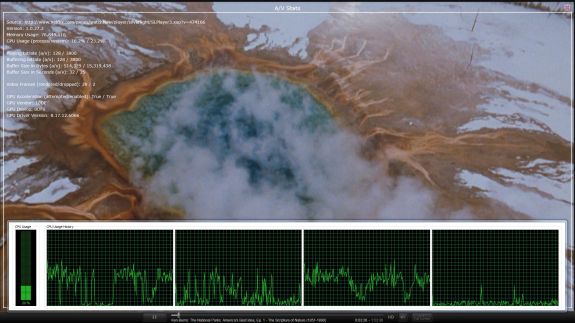ASRock's High-End Vision 3D HTPC Reviewed
by Ganesh T S on October 3, 2010 10:20 AM EST
The networking capabilities of the Vision 3D are quite similar to that of the Core 100. It really doesn't matter if the unit is within reach of a wired network or not. We carried out all our tests with a 300 Mbps 802.11n network (currently provided in my lab location by a RT-N16 802.11n gigabit router from Asus). We were easily able to stream HD clips of more than 50 Mbps. HD YouTube videos and HD Netflix streaming had no issues.
While on the topic of network streaming, let us take a brief look at how the system performs while accessing online video services. The first set of screenshots below show the CPU usage while playing back a 1080p YouTube video with and without hardware acceleration enabled. This is the same clip as the one used in the Core 100 review. As can be seen, the GPU indeed supports Flash acceleration. While the Core 100 had a CPU utilization factor of around 23% with the YouTube clip, the Vision 3D seems to be much more efficient at only 10%. It should also be noted that the software only decode process is also more efficient on the Vision 3D. We expect similar results for videos on Hulu.

YouTube 1080p Playback without HW Acceleration (Click to enlarge)

YouTube 1080p Playback with HW Acceleration (Click to enlarge)
Netflix streaming, on the other hand, uses Microsoft's Silverlight technology. Unlike Flash, hardware acceleration for the video decode process is not controlled by the user. It is upto the server side code to attempt GPU acceleration. Thankfully, Netflix does try to take advantage of the GPU's capabilities. This is evident from the A/V stats recorded while streaming a Netflix HD video at the maximum possible bitrate of 3.8 Mbps. While the video is definitely not 1080p, we observe that the CPU utilization of around 20% is higher than the CPU usage for a 1080p YouTube video.
We suspect that the handling of the DRM in the case of Netflix streaming is done by the CPU, resulting in the higher usage.
Users of media streamers streaming online videos often have to put up with messages of the sort 'This content is not available on TV connected devices' or need to queue up the videos on a PC before accessing them through their media streamer box. HTPC users don't need to worry about any such limitations. For online media consumption, the Vision 3D is better than the Core 100, which itself was a big winner from the network streaming standpoint.











51 Comments
View All Comments
ProDigit - Sunday, October 3, 2010 - link
Looks interesting at first, but I don't much like nvidia graphics cards, and the WD drive.WD drives are known to break right after their warranty expires when using them a lot.
The only good about the nvidia card is that it could be set up to work with CUDA (CPU + GPU in parrallel); although cuda now also supports most ATI/AMD cards.
The price of this setup is quite on the high end. If it wasn't for 3D vision, I'd say this computer would go for no more than $699. With 3D, I'd say $799 max.
I personally don't care if it supports 3D or not, since I have no monitors that support this resolution. So for me it's only worth $599.
ProDigit - Sunday, October 3, 2010 - link
They should have gone with a Toshiba drive instead. Yes, WD has faster continuous write and read speeds, but Toshiba is much better in IO performance.An OS like Windows 7 would boot faster with Toshiba, than with WD, and would run significantly cooler too!
WD is absolutely NOT the best drive they could have chosen! The cheapest perhaps yes.
ganeshts - Sunday, October 3, 2010 - link
Looks like the WD Scorpio Black is as good as the Momentus XT from Seagate (except for the Disk Capture benchmark):http://www.storagereview.com/western_digital_scorp...
So, from a price-performance ratio, it makes sense to go with WD.
I have also mentioned in my review that a mini-PCIE SSD for the boot drive would have been good :)
sprockkets - Sunday, October 3, 2010 - link
The best notebook drives were made by IBM, and now Hitachi. Whether that still is the case, who knows.Zok - Sunday, October 3, 2010 - link
CUDA is not supported on ATI/AMD cards. DirectCompute and OpenCL are, however, supported by both.LtGoonRush - Sunday, October 3, 2010 - link
Studies of both operating disk populations and drives sent in for data recovery show that no brand of drives is measurably more or less reliable than others, with the notable exception of the Seagate model ranges affected by their firmware bugs. It's also been conclusively proven that drive usage doesn't affect failure rates; lightly loaded and heavily loaded drives fail at the same rate. It's true that a failing drive will have its death hastened by heavy load, but you shouldn't be using a drive that's failing anyway, it should be replaced with the first SMART error it logs. The WD Scorpio Black drives in particular are the fastest notebook HDDs available, balancing high throughput with excellent seek times (Seagate drives have always had abysmal seek performance). It's also a little silly to complain about heat when we're talking about drives with sub-4W PEAK power draw.chrnochime - Sunday, October 3, 2010 - link
great job for correcting him without making it more obvious how wrong he is. I would've not sugarcoat it as much as you did though heh.lexluthermiester - Sunday, October 3, 2010 - link
Seriously? Not liking Nvidia, well that is just personal preference. You not having a TV/Monitor that supports what this system can put out is not the fault of the maker or the system itself, it your problem. But bashing WD? They make the finest hard drives in the world and there are certainly worse hard drive makers. Now I'm not going to be low class and name names, but really? And if you don't like this little system, then don't buy it, but don't bash something that certainly has usefulness to a certain audience of users and at a very fair price.Parhel - Sunday, October 3, 2010 - link
False. WD drives are not "known" for high failure rates. All drive manufacturers compare about evenly in most areas. WD is one of, if not the, best choice out there.Samus - Sunday, October 3, 2010 - link
I was a WD fan in the 90's and after the 7200.7's came out and they ditch the wetsuits I became a die-hard Seagate fan because of the 7200.7's legendary reliability, low cost, 5-year warranty and 'decent' performance. These were all big selling points during an era where the Deathstar 75GXP rocked the storage industry with what some circles were calling a "definitive" failure rate within the warranty period.The Seagate drives just worked. However, recently I've had a lot of Seagate 7200.10 and 7200.11 drives giving me SMART errors, specifically reallocated sector counts. They also run hot compared to my new WD Blue 1TB drive and they're all mounted in the same cage. A few years ago I had a 1.5TB Seagate I had to flash to CC1G because of the firmware 'recall' which was definitely a quality control concern. I didn't loose data, but I know somebody who did, one day their drive was just blank. We flashed the firmware and his data was back, but the drive failed after a few months without warning, just spun up and clicked. Tried freezing it. No dice.
Seems like WD is taking the quality/reliability crown, where as they've always had the performance crown...but performance wasn't as important to me as making sure the drive would work for 3-5 years without any issues.
I'd consider a Hitachi in the future, but will probably continue to stick with Seagate and WD drives. Considering how many dead Samsung and Fujitsu drives I've pulled and replaced from friends' desktop and laptop's over the years, it's a no-brainier to stay the hell away from those. Toshiba I have mixed feelings about because over the past 20-years, I just didn't care much for their laptops. Hypocritically, I love Thinkpad's but when IBM had those 75GXP failures, I didn't change my mind about their laptops, and still think they make the best laptop's out there. Ironically things are different now, because Hitachi makes the hard drives and Lenovo makes the Thinkpad's. IBM has little to do with either now.